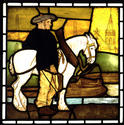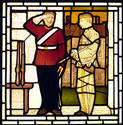 Maryhill originated with the construction of the Forth & Clyde Canal across the River Kelvin in 1790, this proving a focal point for both existing and new industries. By 1830 the original scattered communities had united to form a village based on paper, iron founding, shipbuilding and textiles, the latter employing a significant workforce from Ireland. The building of the railway to Helensburgh and of the Loch Katrine pipeline led to further growth and in 1856 Maryhill became a police burgh. It was absorbed by Glasgow in 1891.
Maryhill originated with the construction of the Forth & Clyde Canal across the River Kelvin in 1790, this proving a focal point for both existing and new industries. By 1830 the original scattered communities had united to form a village based on paper, iron founding, shipbuilding and textiles, the latter employing a significant workforce from Ireland. The building of the railway to Helensburgh and of the Loch Katrine pipeline led to further growth and in 1856 Maryhill became a police burgh. It was absorbed by Glasgow in 1891.
 By this time the textile industry had gone, replaced by brewing, timber, glass, and rubber manufacture located along the Glasgow Branch of the canal. Houses stretched between Maryhill Road and the River Kelvin, both to accommodate the workforce and provide quality flats for city professionals. Most of the original estate lands had been built over, part of Ruchill remaining as a public park and golf course, the mansion becoming a clubhouse.
By this time the textile industry had gone, replaced by brewing, timber, glass, and rubber manufacture located along the Glasgow Branch of the canal. Houses stretched between Maryhill Road and the River Kelvin, both to accommodate the workforce and provide quality flats for city professionals. Most of the original estate lands had been built over, part of Ruchill remaining as a public park and golf course, the mansion becoming a clubhouse.
 Increase in leisure time led to organised sport thriving, Maryhill Harriers and Maryhill Football Club both prospering at the start of the 20th century. The estate of Garrioch was converted into Maryhill Barracks and, when war broke out in 1914, the garrison left for France. With them went the volunteers of the 9th Argyll & Sutherland Highlanders, descendants of the old Maryhill Company of the Dunbartonshire Rifle Volunteers, several of whom had earlier served in South Africa as mounted infantrymen.
Increase in leisure time led to organised sport thriving, Maryhill Harriers and Maryhill Football Club both prospering at the start of the 20th century. The estate of Garrioch was converted into Maryhill Barracks and, when war broke out in 1914, the garrison left for France. With them went the volunteers of the 9th Argyll & Sutherland Highlanders, descendants of the old Maryhill Company of the Dunbartonshire Rifle Volunteers, several of whom had earlier served in South Africa as mounted infantrymen.